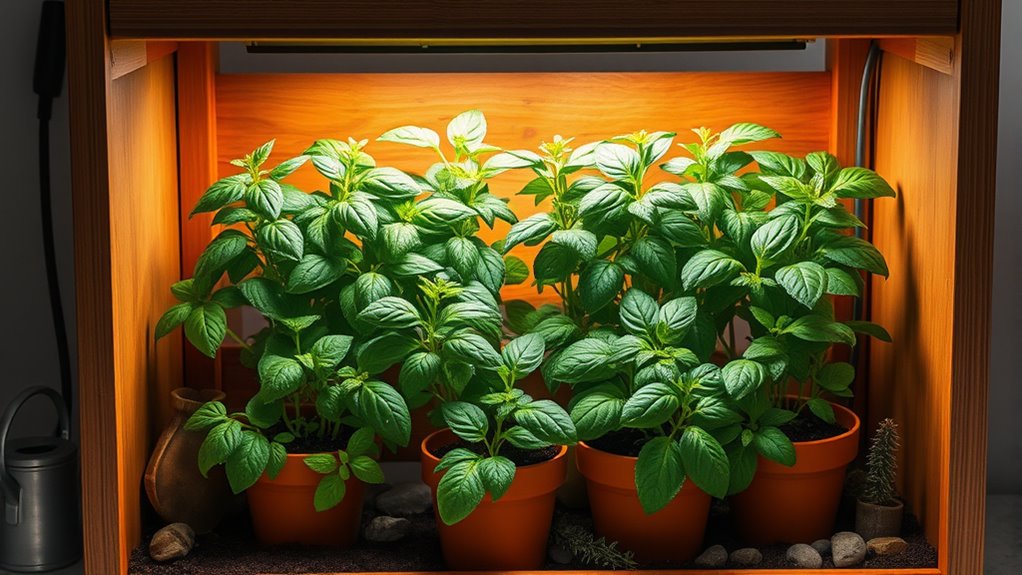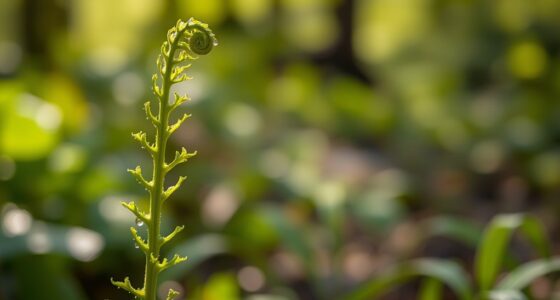To create a mini indoor food forest for year-round herbs, choose a stable spot with good air circulation and indirect sunlight or grow lights. Use containers with drainage and rich, well-draining soil, selecting versatile herbs like basil, mint, and oregano. Arrange the plants thoughtfully for easy access and ideal light, and use artificial lighting if needed. Maintain proper watering, fertilizing, and pest control to keep your herbs thriving—keep exploring for tips on managing your indoor ecosystem effectively.
Key Takeaways
- Select a suitable indoor space with stable humidity, proper air circulation, and ample indirect sunlight or grow lights.
- Choose containers with drainage and rich, balanced soil, and incorporate composting for nutrient-rich growth.
- Plant versatile, resilient herbs like basil, mint, oregano, parsley, and chives for continuous harvests year-round.
- Arrange plants using vertical layering near south-facing windows, and supplement with artificial LED grow lights for consistent illumination.
- Maintain proper watering, fertilize regularly, monitor plant health, and foster biodiversity to ensure a thriving, resilient mini food forest.
Choosing the Ideal Location and Space for Your Food Forest
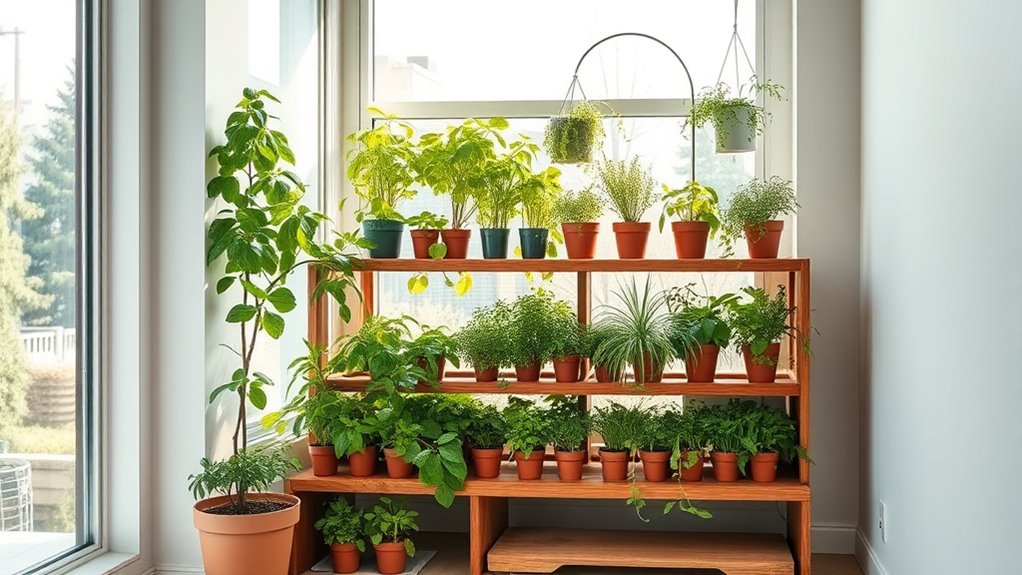
Choosing the right location is essential for your indoor food forest’s success. You need a spot with stable indoor humidity levels to prevent plants from drying out or becoming too damp. Proper air circulation is equally important, as stagnant air can lead to mold and pests. Place your herbs near a window with indirect sunlight or invest in grow lights if natural light is limited. Make certain the space isn’t too crowded, allowing for good airflow around each plant. Avoid areas near heating vents or drafty windows, which can cause fluctuations in humidity and temperature. Additionally, utilizing automation technologies can help maintain consistent environmental conditions, ensuring your herbs thrive year-round. By selecting a well-ventilated, adequately humid spot with consistent conditions, you’ll create an ideal environment for your herbs to thrive year-round.
Selecting the Right Containers and Soil for Indoor Growing
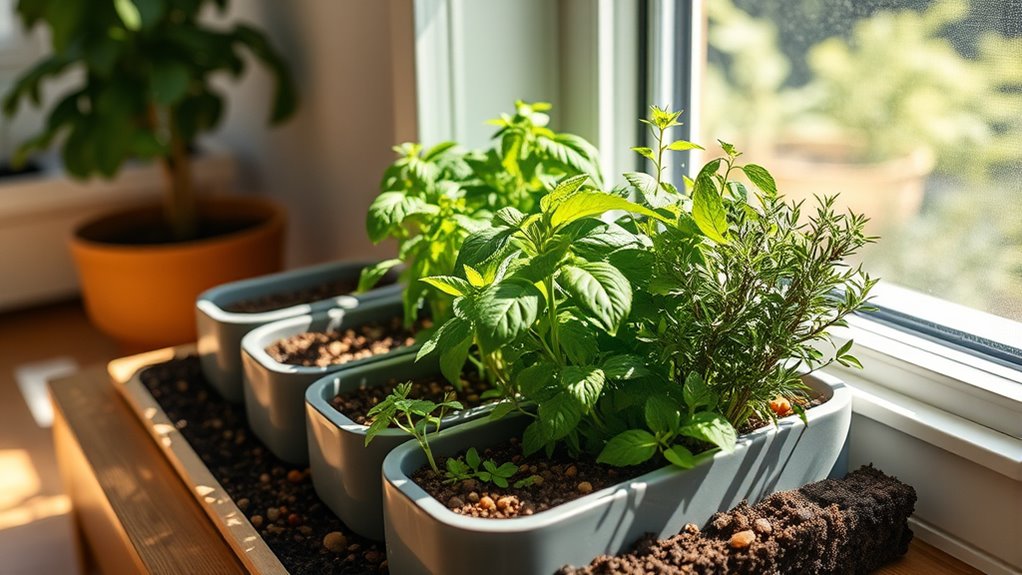
Choosing the right containers is key to healthy herb growth, so pick ones with proper drainage and enough space for roots to expand. Understanding soil composition guarantees your plants get the nutrients they need without becoming waterlogged or too compact. Using high-quality soil ensures optimal plant health and nutrient availability. By focusing on drainage and nutrient balance, you’ll set a strong foundation for a thriving indoor food forest.
Choosing Suitable Containers
Selecting the right containers and soil is essential for ensuring your indoor food forest thrives year-round. When choosing containers, consider container materials like clay, plastic, or metal, which affect drainage and insulation. Clay pots are breathable, helping prevent overwatering, while plastic is lightweight and retains moisture. Think about plant height considerations—taller plants need deeper containers to support root growth, whereas smaller herbs do well in shallower pots. Make sure your containers have drainage holes to prevent water buildup, which can cause root rot. Size matters: too small, and plants become root-bound; too large, and excess soil may retain too much moisture. Properly selected containers set a strong foundation for healthy, productive herbs indoors. Additionally, understanding contrast ratio can help you choose containers that minimize glare and improve light absorption for your plants.
Soil Composition Essentials
Since healthy soil is the foundation of a thriving indoor food forest, understanding soil composition is essential. Your soil needs a balanced mix of organic matter, minerals, and nutrients to support herb growth. Incorporate composting techniques to enrich the soil with vital nutrients, promoting healthy roots and vigorous growth. A good soil mix typically includes components like peat moss, perlite, and compost. Use this table to understand key elements:
| Soil Component | Purpose |
|---|---|
| Organic matter | Improves fertility and structure |
| Minerals | Provides essential nutrients |
| Composting techniques | Boosts soil nutrients naturally |
| pH balance | Ensures nutrient availability |
Focusing on these elements helps you create an optimal environment for your indoor herbs, ensuring a balanced soil environment that supports consistent growth.
Drainage and Nutrients
Healthy soil sets the stage for vibrant herb growth indoors, but to guarantee your plants thrive, you also need containers that promote proper drainage and supply nutrients effectively. Choose containers with drainage holes to prevent waterlogging, which can lead to root rot. Good container drainage ensures excess water escapes, maintaining healthy roots. When managing compost, avoid overloading the soil, as too much organic matter can hinder drainage and cause nutrient imbalances. Incorporate well-draining soil mixes with organic matter like compost to provide steady nutrients, but don’t forget to monitor moisture levels regularly. Proper compost management involves balancing nutrient supply without over-fertilizing, which can lead to salt buildup. Additionally, understanding soil nutrient levels helps ensure your herbs receive the right amount of nourishment for optimal growth. With the right containers and soil, your indoor herbs will flourish year-round, staying healthy and productive.
Picking a Diverse Mix of Herbs and Edible Plants
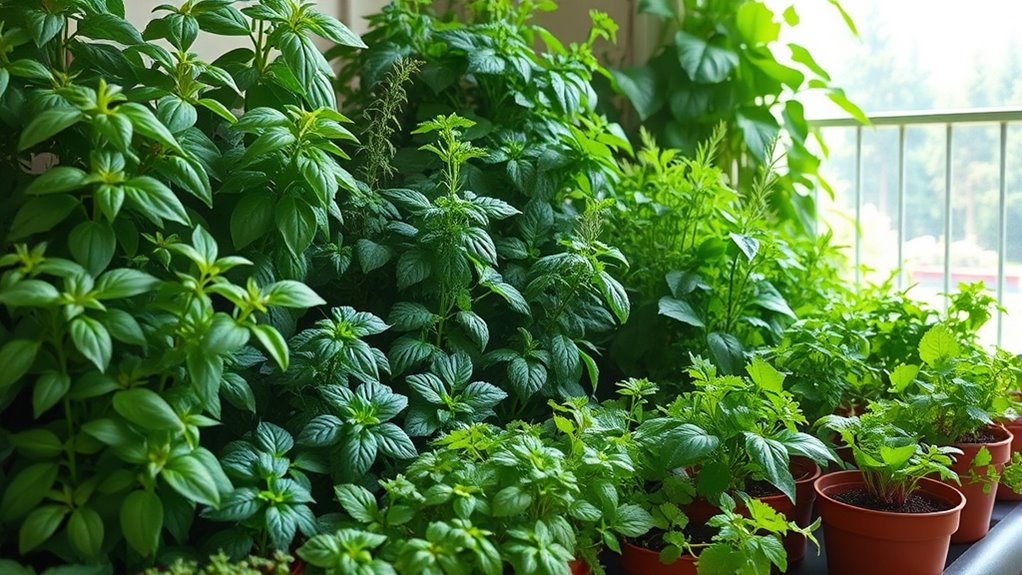
Choosing a mix of versatile herbs and edible plants can keep your indoor food forest productive year-round. Focus on combining varieties that thrive together and provide continuous harvests. This way, you’ll enjoy fresh herbs and produce no matter the season. Incorporating attention and focus into your gardening routine can further enhance your success in maintaining a thriving indoor food forest.
Selecting Versatile Herbs
Selecting versatile herbs for your indoor food forest means choosing plants that thrive in various conditions and serve multiple culinary and medicinal purposes. These herbs should be adaptable and easy to cultivate year-round. Focus on herbal companion planting, which involves pairing herbs that support each other’s growth and health. For example, basil pairs well with tomatoes, while mint can help repel pests. Including a mix of herbs like parsley, chives, and oregano ensures you have fresh flavors for cooking and natural remedies on hand. Choose plants that can tolerate different light levels and moisture conditions, providing resilience to your mini forest. Incorporating plant resilience strategies can help your indoor garden thrive regardless of environmental fluctuations. By selecting adaptable, multipurpose herbs, you create a thriving, sustainable, and productive indoor garden.
Combining Edible Plants
To create a thriving indoor food forest, you should combine a variety of edible plants and herbs that complement each other both visually and functionally. Use companion planting to pair plants that benefit each other — for example, basil and tomatoes or mint and strawberries — to boost growth and deter pests. Mixing herbs with different growth habits and harvesting times encourages continuous production and prevents overcrowding. Incorporate crop rotation principles by periodically changing plant locations to reduce soil depletion and disease buildup, even indoors. This diversity not only maximizes space but also creates a balanced ecosystem. By thoughtfully combining edible plants with complementary traits, you’ll foster a resilient, bountiful indoor food forest that thrives year-round.
Ensuring Year-Round Growth
Ensuring year-round growth in your indoor food forest hinges on planting a diverse mix of herbs and edible plants that thrive under varying conditions. To do this, select species with different growth cycles and light needs, so your garden stays productive through all seasons. Managing indoor humidity is vital; maintaining consistent moisture levels helps plants flourish and reduces stress. Incorporate composting methods suitable for indoor environments to enrich your soil naturally, providing nutrients that support continuous growth. Understanding the importance of plant health and proper care techniques can significantly enhance your garden’s yield. Rotate plants as needed and monitor humidity levels regularly. By combining a variety of herbs and edible plants with proper humidity control and composting techniques, you’ll create a resilient mini food forest that yields fresh herbs and greens all year round.
Planning the Layout for Accessibility and Aesthetic Appeal

Designing your mini indoor food forest with both accessibility and aesthetic appeal in mind guarantees you can easily reach your herbs while creating an inviting space. Use vertical layering to maximize limited space, placing taller plants at the back or on sturdy shelves, and shorter herbs in front for easy access. Incorporate decorative arrangements to enhance visual interest, combining different textures, colors, and containers that complement your interior style. Keep pathways clear and wide enough for comfortable movement, ensuring all plants are within reach for watering and harvesting. Balance functionality with beauty by mixing practical plant placement with attractive displays. Regularly inspecting your plants for health and signs of pests or disease is essential to maintaining a thriving indoor food forest. Thoughtful planning ensures your indoor food forest is both a lush, productive garden and a pleasing space you enjoy spending time in.
Light Requirements and How to Maximize Natural Sunlight
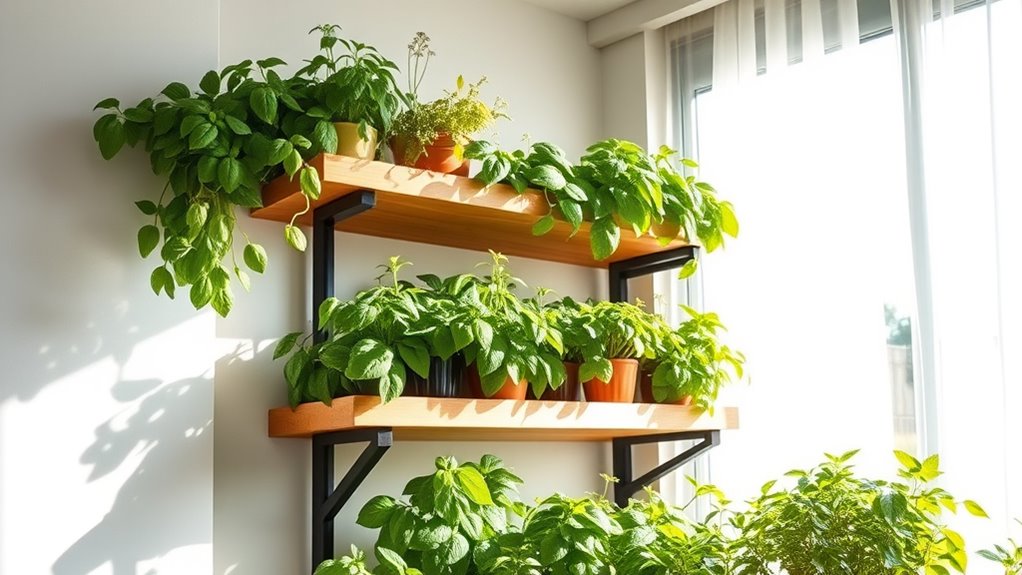
Maximizing natural sunlight is essential for keeping your indoor herbs healthy and thriving year-round. To achieve ideal light, focus on light optimization techniques that guarantee your herbs receive enough natural sunlight each day. Consider these four key steps:
- Position your herbs near south-facing windows for maximum exposure.
- Keep windows clean to allow unobstructed sunlight penetration.
- Rotate your plants regularly to ensure even light distribution.
- Use reflective surfaces like white walls or aluminum foil to bounce light and boost overall illumination.
Additionally, understanding the signs of spoilage in lemon juice can help ensure your ingredients stay fresh and safe to use.
Supplementing With Artificial Lighting and Grow Lights
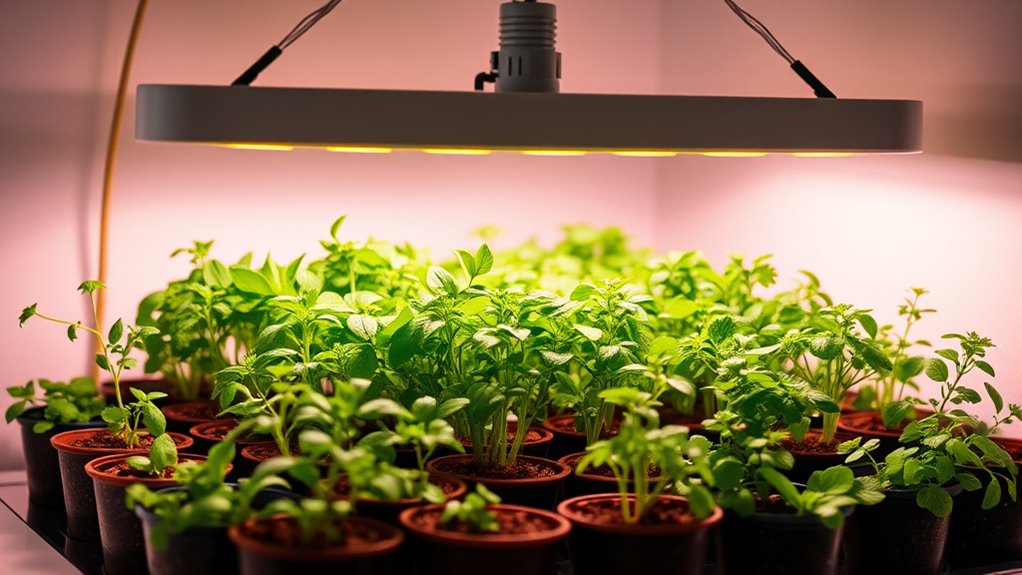
When natural sunlight isn’t enough to meet your herb’s needs, supplementing with artificial lighting and grow lights becomes essential. Artificial lighting provides the necessary light spectrum for healthy growth, especially during winter months or in low-light spaces. To maximize effectiveness, pay close attention to grow light placement; position the lights about 2-4 inches above your herbs, adjusting as they grow taller. Use full-spectrum LED grow lights for ideal results, ensuring your herbs receive the right balance of light. Consistent lighting schedules—typically 12-16 hours daily—help mimic natural sunlight. Proper placement and timing encourage lush, healthy herbs year-round, making your mini indoor food forest thrive even when sunlight is limited.
Watering, Fertilizing, and Maintaining Healthy Plants
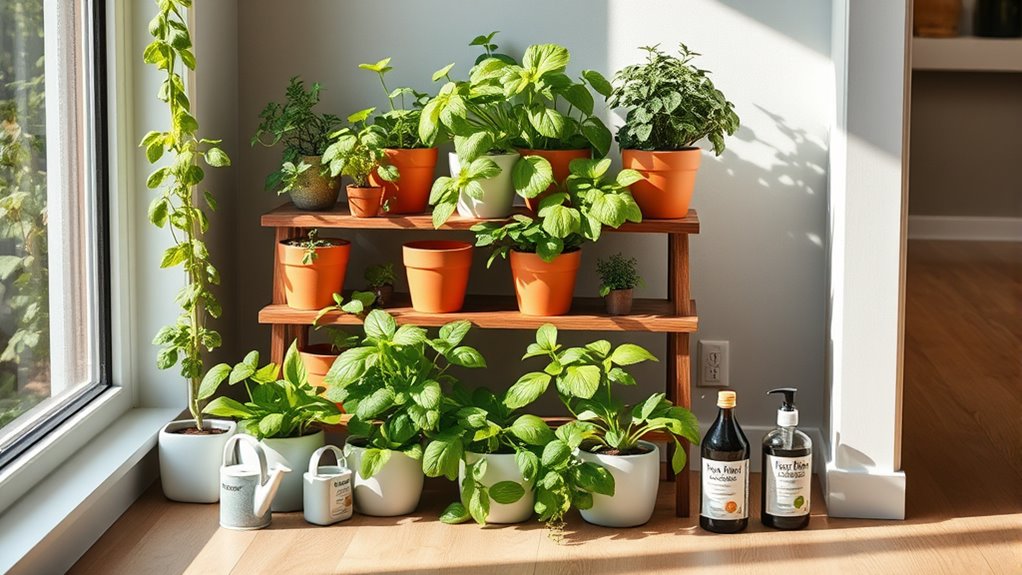
To keep your herbs thriving, maintaining a consistent watering and fertilizing routine while monitoring their overall health is vital. Proper watering frequency ensures your plants don’t drown or dry out, so check soil moisture regularly. Follow a fertilization schedule tailored to each herb’s needs; typically, every 2-3 weeks with a balanced liquid fertilizer works well. Here are key tips to keep your herbs healthy:
- Feel the soil before watering—only water when it’s dry.
- Use a gentle, consistent watering method to prevent overwatering.
- Fertilize lightly but regularly to promote growth.
- Watch for signs of stress or nutrient deficiency, adjusting your routine as needed.
Staying attentive helps your herbs flourish all year round.
Managing Pests and Preventing Common Indoor Plant Problems
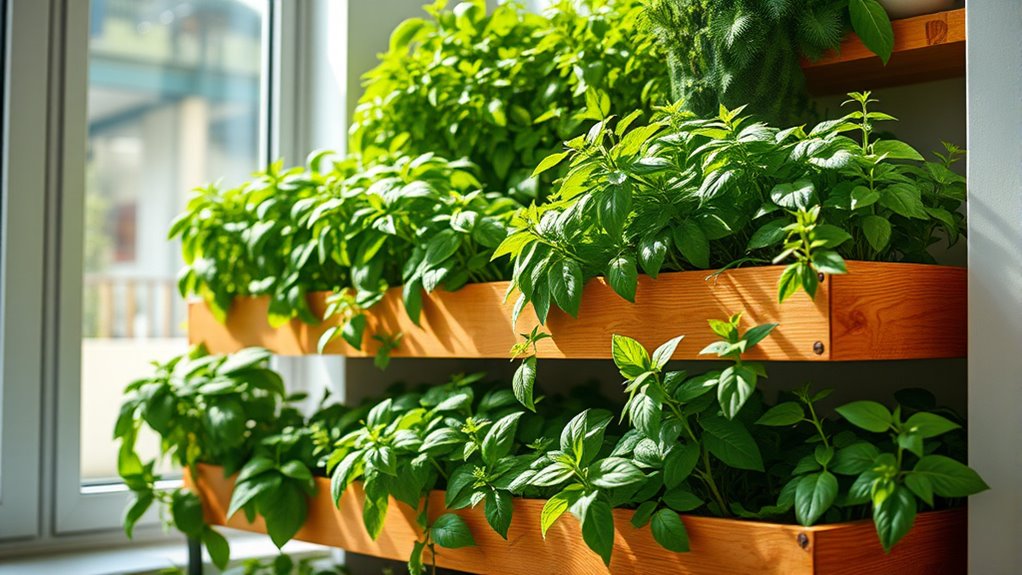
Even with careful care, indoor herbs can fall prey to pests and common problems that hinder their growth. To keep your herbs healthy, focus on effective pest control methods, like inspecting plants regularly and removing pests by hand or with neem oil. Prevent plant diseases by ensuring proper airflow and avoiding overwatering, which can lead to mold or root rot. Keep humidity levels balanced and remove any dead or decaying leaves promptly to minimize disease risks. Quarantining new plants before adding them to your indoor garden helps prevent the introduction of pests or illnesses. Consistent monitoring and prompt action are key to managing pests and preventing common plant problems, ensuring your indoor food forest remains vibrant and productive year-round.
Tips for Sustaining and Expanding Your Indoor Food Forest
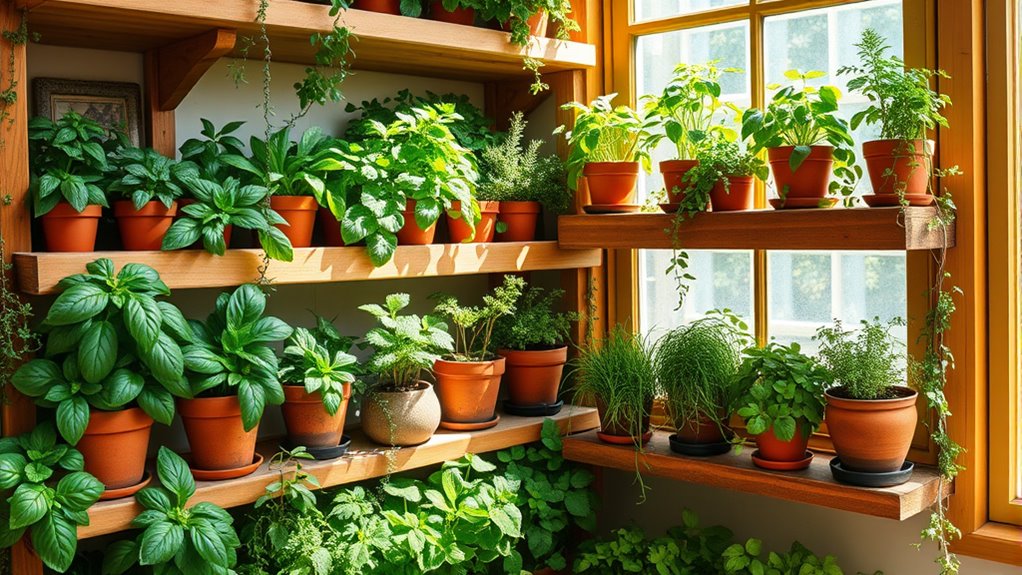
Maintaining and expanding your indoor food forest requires consistent effort and strategic planning. To keep your herbs thriving, focus on techniques like companion planting, which boosts growth and ward off pests naturally. Practice crop rotation to prevent soil depletion and reduce disease buildup, even indoors. Here are four tips to help you succeed:
Consistent care and strategic planting keep your indoor food forest healthy and productive.
- Mix compatible plants to enhance growth and repel pests.
- Rotate herbs seasonally to maintain soil health and prevent nutrient exhaustion.
- Regularly prune plants to promote airflow and prevent overcrowding.
- Monitor for signs of stress or pests, and adjust your planting plan accordingly.
Frequently Asked Questions
How Do I Prevent My Indoor Herbs From Overgrowing in Limited Space?
To prevent your indoor herbs from overgrowing in limited space, you should use pruning techniques regularly. Trim back excess growth to keep plants manageable and encourage healthy development. Also, optimize space by choosing compact herb varieties and arranging them vertically or in multi-tiered containers. This approach helps maintain a tidy, thriving indoor herb garden, ensuring each plant gets enough light and air without overcrowding your space.
What Are the Best Ways to Control Indoor Pests Naturally?
Imagine pests invading your indoor herb haven—don’t panic. You can control them naturally with strategic methods. Use companion planting to deter pests while encouraging healthy growth. Introduce biological controls like beneficial insects or organic sprays to keep the balance. These eco-friendly solutions protect your herbs without harmful chemicals, ensuring your indoor food forest remains vibrant and pest-free all year round. Stay vigilant, and nature will do the rest.
How Often Should I Rotate My Potted Herbs for Even Growth?
You should rotate your potted herbs weekly to promote even growth and prevent them from leaning toward the light. Incorporate regular herb pruning to encourage bushier growth and remove dead or yellowing leaves. Adjust your watering schedule based on the herbs’ needs, ensuring soil stays moist but not waterlogged. Regular rotation and pruning, combined with proper watering, help your herbs thrive indoors all year round.
Can I Grow Root Vegetables Alongside Herbs Indoors?
Imagine planting carrots alongside your herbs, like basil or parsley, in a small indoor garden. You can grow root vegetables indoors, but focus on companion planting and soil layering. Root vegetables need deep, loose soil, while herbs thrive in well-draining pots. Combining them works if you give each plant proper space and nutrients, creating a mini food forest that maximizes your indoor space and promotes healthy growth for both.
What Are Signs of Nutrient Deficiencies in Indoor Edible Plants?
You should watch for yellowing leaves, stunted growth, or leaf drop as signs of nutrient deficiencies. To confirm, consider soil testing to check nutrient levels or perform a foliar analysis for a quick assessment. If deficiencies are detected, amend your soil with appropriate fertilizers. Regular monitoring helps keep your indoor edible plants healthy, ensuring they get the nutrients needed for robust growth year-round.
Conclusion
Creating your indoor food forest is a rewarding way to enjoy fresh herbs year-round. Did you know that indoor herb gardens can yield up to 10 times more produce per square foot than traditional outdoor gardens? With the right space, lighting, and care, you can transform any corner into a lush, sustainable food source. Stay consistent, experiment with different plants, and enjoy the fresh flavors and health benefits your indoor garden provides all year long.
